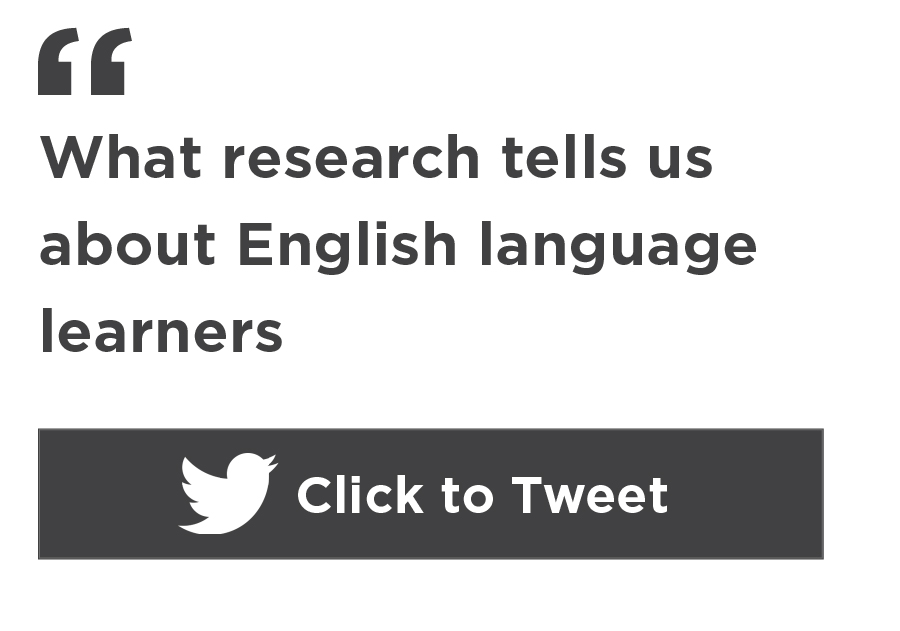As the US population grows, so does the number of students in our schools who don’t speak English as a first language. In fact, the number of English language learners grew by 28.1% between the 2000–2001 and 2016–2017 school years, according to a report issued by the Department of Education’s Office of English Language Acquisition.
I recently sat down with Angela Johnson, a member of the research team at NWEA, to learn more about her work with English language learners. Her answers have been edited for length and clarity.
Can you tell us a little bit about yourself and what motivates you in the research you do?
I am a research scientist and my work focuses on education policies and programs that serve multilingual students. This research is very close to my heart because I was an English language learner.
My family moved a lot when I was growing up. By the time I was in sixth grade, I had already attended schools in three countries. Learning new languages and learning in different languages was at the center of my own schooling. I experienced what multilingual students continue to experience. Without amazing support from my schools and teachers, I would not have been able to find academic success and become an education researcher.
My research is motivated by the conviction that all multilingual students can succeed, and my goal is to help schools provide each student with the support they need.
Some of your recent work, like your papers on students’ English learner status and special education placement and on academic growth of students who are English learners, has provided some really interesting insights. Would you please share a few things that surprised you or that you think are especially important to know and understand about students who are learing English?
I came to appreciate the rich diversity in the multilingual student population through this work.
Multilingual students in this nation come to school from different cultural, linguistic, socioeconomic, and educational backgrounds and experiences, and their schooling experiences in the United States can also vary a great deal because state and local policies and programs differ. In the special education placement study, for example, we found that English language learners who speak Spanish were under-placed in special education services, whereas those who speak Chinese or another language were proportionately placed in special education services.
The potential effects of disproportionate placement in special education services are not yet clear, but what is clear is that students’ educational experiences can differ based on their home language and many other factors. Addressing diversity and targeting services are key to supporting multilingual students.
The NWEA Center for School and Student Progress often works with districts in research-practice partnerships. How does that play a role in your work?
Most of my research is done in close collaboration with school districts. Currently I am working on several large-scale projects with districts in the Western and Midwestern parts of the United States to examine programs and practices that serve multilingual students. I meet with administrators and teachers on a regular basis to discuss the questions, methods, and findings of our studies. Listening to them is a key part of my work and my favorite part; it helps me understand and appreciate the context of teaching and learning and keeps my research grounded in practice.
It sounds like there is still much for us to learn so we can partner well with educators working to support students who are English language learners. Can you tell us about other questions you’re exploring or want to explore?
My ongoing work seeks descriptive and causal evidence for the extent to which programs serving multilingual students are effective. But embedded in this larger question of effectiveness are many focused questions, like what makes a program effective, and effective for whom? Multilingual students in our education systems are diverse in many ways, and so are the schools and programs that serve them. I am very interested in exploring the heterogeneity and identifying practices that are working especially well for certain groups of students.
Are there some resources you’d recommend for educators working with students who are English Learners who want to understand research that may be helpful in their schools?
Colorín Colorado is one of my go-to websites. It has great resources for educators and student families and is frequently updated with news and research.
Finally, there is a growing body of research that finds significant benefits of bilingualism (and multilingualism). For example, Steele et al.’s 2017 study highlights increased metalinguistic awareness, or the ability for students to be more aware of how language works. Can you offer one or two areas where English language learners particularly excel?
There has been a lot of research interest around the effects of multilingualism. One of my current studies looks at the math and reading growth rates of students in a Spanish-English dual language program. I found that compared to similar Hispanic students not in dual language, Hispanic students in the dual language program (who are learning academic content in both Spanish and English) grew more in math during each academic year between second and fifth grade. This is very encouraging, although it’s not yet clear what part of the dual language learning is driving the differential growth.
Another important consideration is maintaining learning when students are not in school, for example, during summer vacations. In order to have equitable outcomes in the long run, we need to make sure students are not only learning while they’re in school but also maintaining what they learned outside of school.









